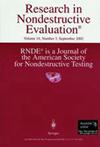基于孤立波的腐蚀损伤检测与分类
IF 1
4区 材料科学
Q3 MATERIALS SCIENCE, CHARACTERIZATION & TESTING
引用次数: 2
摘要
本文提出了一种基于高度非线性孤立波、无线传感器和机器学习的检测技术。在实验室设计和组装的有线和无线传感器监测下,该技术在经受加速腐蚀的板上进行了演示。该系绳装置由一串球体组成,上面有一个螺线管,该螺线管连接到数据采集系统,由数据采集系统驱动,以控制链上的第一个颗粒,从而诱导颗粒与链之间的碰撞,从而产生应力波。链条上有一个压电晶片盘,也连接到相同的数据采集系统,用来感应海浪。无线换能器与有线换能器相同,但数据采集系统被一个通过蓝牙与平板电脑通信的无线节点所取代。使用四个有线和四个无线传感器对钢板进行近一周的监测,以检测电化学腐蚀的发生和进展。从时间波形中提取一些特征,然后将其输入机器学习算法进行损伤分类。结果表明,所提出的方法在标记靠近传感器的缺陷时是有效的。本文章由计算机程序翻译,如有差异,请以英文原文为准。
Detection and Classification of Corrosion-related Damage Using Solitary Waves
ABSTRACT This paper presents an inspection technique based on highly nonlinear solitary waves, wireless transducers, and machine learning. The technique was demonstrated on a plate subjected to accelerated corrosion while monitored with wired and wireless transducers, designed and assembled in laboratory. The tethered device consisted of a chain of spheres surmounted by a solenoid wired to and driven by a data acquisition system to control the first particle of the chain in order to induce the impact between the particle and the chain needed to generate the stress wave. The chain contained a piezoelectric wafer disk, also wired to the same data acquisition system, to sense the waves. The wireless transducers were identical to their wired counterparts, but the data acquisition system was replaced by a wireless node that communicated with a tablet via Bluetooth. Four wired and four wireless transducers were used to monitor the plate for nearly a week to detect the onset and progression of electrochemical corrosion. A few features were extracted from the time waveforms and then fed to a machine learning algorithm to classify damage. The results showed the effectiveness of the proposed approach at labeling defects close to the transducers.
求助全文
通过发布文献求助,成功后即可免费获取论文全文。
去求助
来源期刊

Research in Nondestructive Evaluation
工程技术-材料科学:表征与测试
CiteScore
2.30
自引率
0.00%
发文量
14
审稿时长
>12 weeks
期刊介绍:
Research in Nondestructive Evaluation® is the archival research journal of the American Society for Nondestructive Testing, Inc. RNDE® contains the results of original research in all areas of nondestructive evaluation (NDE). The journal covers experimental and theoretical investigations dealing with the scientific and engineering bases of NDE, its measurement and methodology, and a wide range of applications to materials and structures that relate to the entire life cycle, from manufacture to use and retirement.
Illustrative topics include advances in the underlying science of acoustic, thermal, electrical, magnetic, optical and ionizing radiation techniques and their applications to NDE problems. These problems include the nondestructive characterization of a wide variety of material properties and their degradation in service, nonintrusive sensors for monitoring manufacturing and materials processes, new techniques and combinations of techniques for detecting and characterizing hidden discontinuities and distributed damage in materials, standardization concepts and quantitative approaches for advanced NDE techniques, and long-term continuous monitoring of structures and assemblies. Of particular interest is research which elucidates how to evaluate the effects of imperfect material condition, as quantified by nondestructive measurement, on the functional performance.
 求助内容:
求助内容: 应助结果提醒方式:
应助结果提醒方式:


